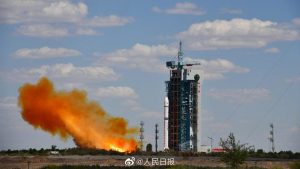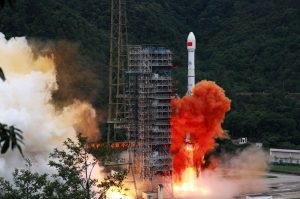Media
Transcript
First up, a China Long March 2D rocket launched on Wednesday, June 17, 2020, at 7:19 AM (UTC).
The rocket carried three satellites to low earth orbit: GaoFen-9 03, HEAD-5, and Pixing-3A.

GaoFen-9 03 is an optical remote sensing satellite. According to Xinhua, it will be used in areas such as land census, urban planning, land rights determination, road network design, crop estimation and disaster prevention and reduction. The optical sensors are really high resolution. Each pixel of an image captured represents less than a meter on the Earth.
HEAD-5 is the fifth satellite in the HEAD constellation. They are used for ship monitoring by receiving the Automated Identification System (AIS) signals that ships continually broadcast. It has a mass of 45 kilograms; for Americans, that’s 23 two-liter soda bottles.
Pixing-3A is a nano-satellite that is testing technology that will be used for the collection of global ship navigation and flight status data.
About a week later, China also launched another rocket at 01:43 am UTC on June 23rd.
A Long March 3B rocket carried the very last BeiDou 3 into orbit, completing the constellation of satellites for China’s BeiDou Navigation Satellite System, or BDS.
The BeiDou constellation is China’s version of a navigation satellite system like GPS, Galileo, or GLONASS. This particular satellite is headed for a geostationary orbit about 36,000 kilometers (22,000 miles) above the Earth’s equator. Once in that orbit, it will follow the Earth’s rotation, which will make it appear as a stationary object from the ground.

BeiDou is the Chinese name for the Big Dipper, which can be used to find the surprisingly faint North Star (also known as Polaris). Historically, Polaris was a common reference point for navigation. So, if you’d like, think of the Big Dipper — BeiDou — showing you the way.
The launch itself was flawless, and our viewers on Twitch were treated to a rare official live stream from Chinese media that covered pre-launch activities all the way to the deployment of the solar panels after separation of the satellite from the launch vehicle.
Both Long March rockets used the pretty but deadly nitrogen tetroxide and unsymmetrical dimethylhydrazine, resulting in an ominous — and highly toxic — red-orange flame and smoke plume that could be seen right after liftoff.
China typically launches from sites well inland, so their lower stages routinely crash back to Earth — sometimes on top of buildings and personal property. This time, it doesn’t appear that any homes were damaged.
What appears to be part of the first stage landed near Tongren in Guizhou province.
Locals took pictures of the debris and shared them on Weibo, a Chinese social media network.
To the best of our knowledge, no cows were harmed during this launch.
To wrap things up, here’s a running tally of a few spaceflight statistics for the current year:
Toilets currently in space: 4
Toilets burned up: 2
Total satellites humans put into orbit: 545 (includes those launched from other in-orbit craft, such as the ISS)
Total satellites from launches: 529
Total 2020 launch attempts: 45 (including 5 failures)
I keep track of orbital launches by where they launched from, also known as a spaceport. Here’s that breakdown:

USA: 15
China: 15
Kazakhstan: 4
Russia: 3
French Guiana: 2
Iran: 2
Japan: 2
New Zealand: 2
Your useless space fact for the week is that there at least 45 windows in space.
Learn More
China Long March 2D rocket launched on Wednesday, June 17, 2020
- Xinhua news article [Chinese]
- Gaofen 9-01, 02, 03 (Gunter’s Space Page)
- HEAD 1, 2A, 2B, 3, 4, 5 (Gunter’s Space Page)
- Zheda Pixing 3A (Gunter’s Space Page)
The BDS-3 Constellation Deployment Is Fully Completed Six Months Ahead of Schedule
- BeiDou Navigation Satellite System news release
- Xinhua news article [Chinese]
- Spaceflight Now article
Credits
Host: Annie Wilson
Writers: Annie Wilson, Dave Ballard, Gordon Dewis, Ally Pelphrey
Audio and Video Editing: Ally Pelphrey
Content Editing by Beth Johnson
Executive Producer: Pamela Gay
Intro and Outro music by Kevin MacLeod, https://incompetech.com/music/


 We record most shows live, on Twitch. Follow us today to get alerts when we go live.
We record most shows live, on Twitch. Follow us today to get alerts when we go live.